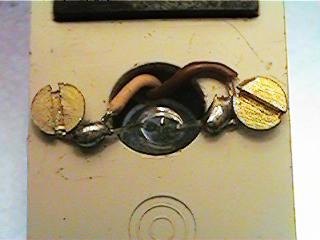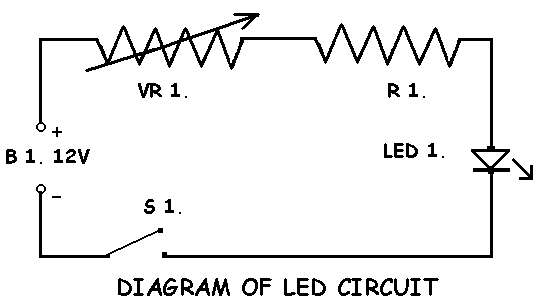SOME
EXPERIMENTAL IDEAS FOR ADAPTING THE O.U. MICROSCOPE WITH A WHITE
LED LIGHT SOURCE.
by
Brian Darnton, UK
(See footnote if unfamiliar with the O.U.
microscope)
INTRODUCTION.
Some literature on the application of Maplin`s
white light LED already exists (ref. 1). Most people seem to use
the OU microscope more or less as supplied, but with some form of
3 Volt power pack attached, usually on a short lead. Often this
is strapped to the body of the microscope deviating from the
original principles of portability and compactness envisaged by
the designer. The 3V prefocus bulb is not very economical on
power use and the power source has to be replaced or charged
quite frequently. The new white LED light source from Maplin
seems to have very good characteristics for use with the
microscope. It has a brilliant white colour with a hint of blue.
It is even strong enough for use with crossed polars.
 ADAPTATION.
ADAPTATION.
The existing light fittings can easily be removed from the
instrument.
Vertically above the centre of the microscope object position is
an aperture with two holes, one on either side. An LED can be
inserted downward into this cavity and secured by 2 self tapping
brass screws into the pair of holes. The LED leads wrap neatly
round the shafts of the two screws Two insulated wires can be
taken from these screws through the switch space to the battery
area. A compact capping to this assembly would improve the
neatness of it.
A small 1K ohm potentiometer and a press button
switch are best mounted in one side of the body so that they can
be accessed during viewing by ones fingers. As can be seen in the
circuit diagram (below) all the components can be connected by
soldering in series with one another to complete the circuit. In
connecting both the battery and the LED, polarity must be
observed or the light will fail to function. Some form of heat
sink is required on the LED leads to avoid damage during
soldering.

It's a good idea to make a loose mock-up before
soldering the components in order to check for functioning. The
battery is of a fairly low capacity type but is quite suitable
for the casual viewing by the OU Microscope particularly when a
press button is used to ensure economic use. It is of course no
use at all for long term use, but it has an alternative advantage
in that it could be plugged into the 12V source from a motor car
provided polarity is observed and the 12 Volt battery
disconnected. The components would then remain at the same
values. The small battery itself can be taped round and stowed in
the old battery cavity and the old slider cover can be replaced
to conceal the wires and components.
AN ALTERNATIVE CONTROL SWITCH.
In order to control brightness, one could of course use a
sub-miniature single pole 6 way switch rather than R 1, (the
potentiometer), and a bank of 330 Ohm 1/4 Watt resistors
connected in series configuration. If the first position is left
blank (with no connections) it could also double as the master
on/off switch.
As with any microscope, maximum brightness can
damage ones eyesight, but manipulation of the the potentiometer
should gain complete control of light levels as well as
introducing another element of economy. If the microscope is to
be boxed and stored it's a good idea to fit an extra slider
switch is in series with the press button, to prevent accidental
pressure in transit from switching on the light. The measured
voltage accross the LED device is about 3.5 Volts and the current
should be always limited to less than 25 ma. If the load
resistance is reduced to less than the 560 ohm prescribed it
could blow up and cause damage!
The system suffers from one disadvantage in that it is only
suitable for transmitted light, though it not impossible to mount
a second LED that could illuminate the object at about 45
degrees; there is the space for the innovative worker.
Note.
This article is intended for guidance only to
stimulate innovation. The information is given in good faith for
those that have the knowledge to undertake this level of
electrical work and the writer can not be responsible for damage
occasioned by accidental or faulty procedures. Some warning are
given.
COMPONENTS
VR1 1 K Ohm Variable Resistance
R1 560 Ohm 1/4 Watt Fixed Resistance
B1 12 volt Reserve Battery Soldered on LRV08 at £1.50 +-
LED1 The new Maplin White LED NR73Q
S1 Press on sub min switch.
TECHNICAL INFORMATION
Size 5mm white LED NR73Q MAPLIN at a cost
of £2.54 per one EXCl. VAT & P+P 6/1999. Or at a cost of
£1.99 per 25 EXCL. VAT & P+P 6/1999.
Forward Voltage 3.6 Volts
Forward Current 25MA
Reverse voltage 5 Volts
Power Dissipation 100 mW
Colour Temperature 8000 deg K.
References.
1# Tony Saunders-Davies. QMC publication:
An initial summary of the LED's
potential use. Article on the Quekett Club website.
2# THE MAPLIN WHITE LED LINK
A summary of technical information and
updated costs on the Maplin web site.
Comments to the author Brian
Darnton welcomed.
Editor's Notes:
The OU microscope is the Open University portable microscope
based on the McArthur design. This microscope is available
secondhand via the Microscopy
UK On-line shop.
Maplin is a major UK electronic components supplier. Other
countries suppliers may offer a similar LED.
© Microscopy UK or their
contributors.
Published in the July 1999
edition of Micscape Magazine.
Please report any Web problems
or offer general comments to the Micscape Editor,
via the contact on current Micscape Index.
Micscape is the on-line monthly
magazine of the Microscopy UK web
site at Microscopy-UK
WIDTH=1
© Onview.net Ltd, Microscopy-UK, and all contributors 1995 onwards. All rights
reserved. Main site is at www.microscopy-uk.org.uk with full mirror at www.microscopy-uk.net.
 ADAPTATION.
ADAPTATION.